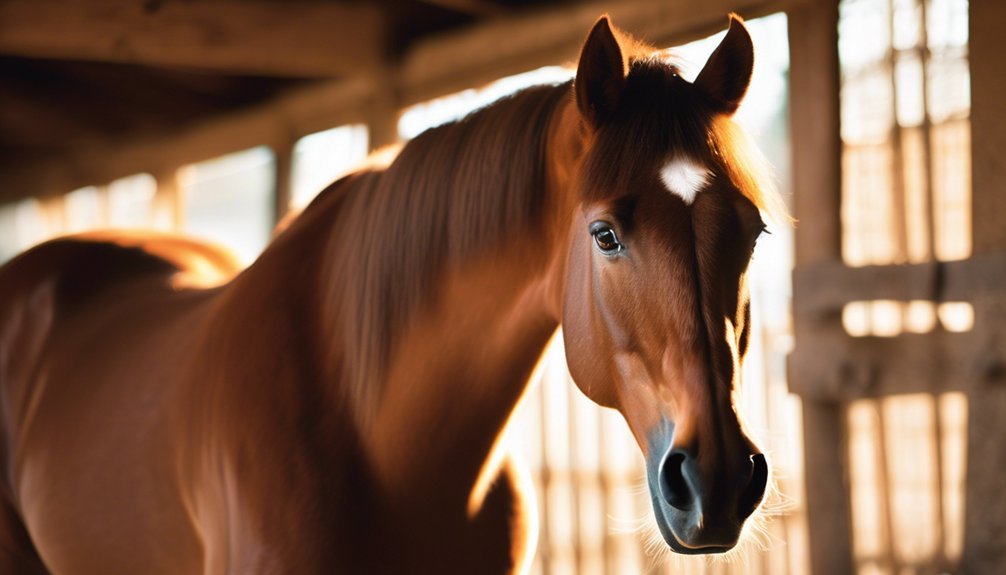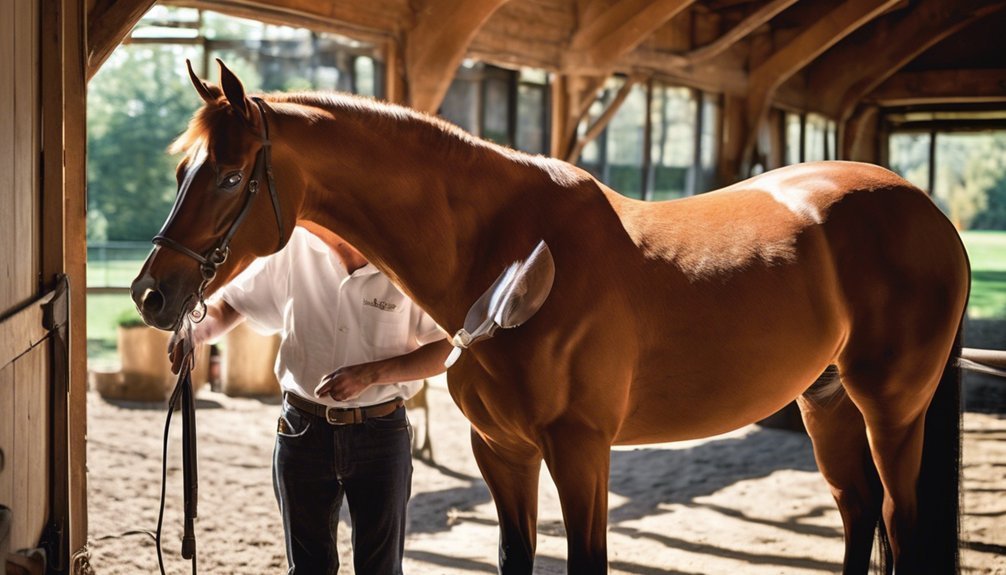
Grooming young horses is more than just a beauty routine; it's a vital step in fostering a meaningful relationship with your equine companion. Regular grooming not only enhances their physical appearance but also plays a crucial role in their overall well-being. By establishing a consistent grooming practice, you'll uncover health benefits and set the stage for effective training. What techniques can you use to make this experience mutually beneficial?
Key Takeaways
- Grooming builds trust between young horses and handlers through gentle touch and calm handling techniques.
- Regular grooming enhances coat condition, promotes healthy skin, and supports overall horse well-being.
- It provides opportunities for early detection of skin issues and injuries, allowing for timely treatment.
- Grooming sessions help promote relaxation and comfort in young horses, creating a secure environment.
- Consistent grooming routines establish good habits and reinforce the bond, making horses feel valued and safe.
Building Trust Through Grooming

When you start grooming a young horse, you're not just cleaning its coat; you're laying the foundation for a trusting relationship.
Employing effective grooming techniques, like gentle brushing and calm handling, fosters a sense of security. As you move your hands over its body, you're not only removing dirt but also building trust. Use soft brushes and take your time, letting the horse acclimate to your touch.
Observe its reactions; a relaxed horse indicates that trust is forming. Consistency in your grooming routine reinforces this bond, making the horse more receptive to your presence.
Health Benefits of Regular Grooming
While you may think of grooming as merely a cosmetic practice, it plays a crucial role in your young horse's overall health. Regular grooming frequency not only enhances their coat condition but also stimulates skin circulation, promoting healthy hair growth.
As you brush, you're more likely to notice changes in your horse's body, such as weight fluctuations or subtle shifts in muscle tone. This awareness fosters a deeper bond and helps you address any potential health issues early on.
Additionally, grooming can reduce stress, providing comfort and relaxation for your horse. By prioritizing grooming, you're ensuring that your young equine companion stays healthy, happy, and ready to thrive in their training and development.
Early Detection of Skin Issues and Injuries

Regular grooming not only promotes overall health but also serves as a key opportunity for early detection of skin issues and injuries in young horses.
During each grooming session, you should perform a thorough skin inspection, checking for unusual bumps, lesions, or signs of irritation. Catching these issues early can lead to effective treatment, preventing more serious conditions from developing.
Additionally, consistent grooming helps you identify minor injuries before they escalate, ensuring timely intervention and injury prevention.
Your attentive care fosters a strong bond with your horse, allowing you to recognize their unique physical traits and behaviors.
Promoting Relaxation and Comfort
Grooming your young horse isn't just about maintaining a shiny coat; it's also an essential practice for promoting relaxation and comfort.
Creating a calm environment during grooming helps your horse feel secure and at ease. Use soothing techniques like gentle brushing and rhythmic strokes to ease tension and foster trust. This tactile interaction not only relaxes the muscles but also enhances your bond.
Pay attention to your horse's body language; if they seem tense, adjust your approach or take a break. Incorporating calming scents, such as lavender, can further enhance the experience.
Establishing Good Habits and Routine

To ensure your young horse develops good habits, consistency in grooming routines is key. Establishing a grooming schedule allows your horse to anticipate and understand what to expect, making the process smoother for both of you.
Incorporate regular sessions to focus on different areas, such as brushing, hoof care, and mane tidying. While you groom, use positive reinforcement—praising your horse with gentle words or treats when they stand still or respond well. This builds trust and encourages them to engage willingly in grooming sessions.
Consistent routines paired with positive reinforcement create a safe environment where your horse feels secure and valued, laying the foundation for a strong working relationship.
Enhancing Bonding Between Horse and Handler
Building on the foundation laid through consistent grooming routines, enhancing the bond between you and your young horse involves engaging in meaningful interactions that foster trust and connection.
Incorporate bonding activities into your daily routine, such as gentle touch and voice cues, which help your horse feel secure. You can also introduce grooming games, like using a soft brush to create playful challenges that encourage your horse to participate. This not only makes grooming enjoyable but also strengthens your relationship.
Preparing for Training and Performance

As you prepare your young horse for training and performance, it's crucial to establish a solid foundation that emphasizes physical and mental readiness.
Start with groundwork exercises that promote balance, coordination, and confidence. These exercises not only prepare your horse physically but also help them understand the expectations you have.
Incorporating positive reinforcement during these sessions fosters trust and encourages a willingness to learn. Celebrate small achievements with praise or treats, reinforcing the connection between effort and reward.
Socialization and Human Interaction
Groundwork exercises lay the groundwork for a young horse's development, but socialization and human interaction play equally important roles in shaping their temperament and behavior.
Engaging with your young horse regularly helps them develop essential social skills. Start by exposing them to various environments, sounds, and people, fostering their confidence. Use positive reinforcement to reward calm behavior during these interactions. This builds trust and encourages a willingness to engage with both humans and other horses.
Developing Sensitivity to Touch

While many aspects of a young horse's training focus on establishing trust and communication, developing sensitivity to touch is crucial for their overall comfort and responsiveness.
Sensitivity training lays the foundation for a trusting relationship, making your horse more receptive to handling and interaction.
Here are three vital steps to consider in touch desensitization:
- Start Slowly: Begin with gentle touches in familiar areas, allowing your horse to acclimate gradually.
- Use Varied Pressures: Progress from light strokes to firmer pressure, helping your horse learn to accept different sensations.
- Incorporate Movement: Introduce movement with your hands or tools to simulate various interactions, reinforcing their comfort with touch.
Grooming Tools and Techniques for Young Horses
Choosing the right grooming tools and techniques is essential for fostering a positive experience with young horses. Start with gentle grooming brushes that suit their sensitive skin, ensuring you create a soothing atmosphere.
Establish a consistent grooming schedule to build trust and familiarity. Don't forget hoof care; regularly check and clean their hooves to promote overall health.
For mane and tail care, use appropriate detangling tools to prevent discomfort. During shedding season, shedding tools can help maintain coat health.
When necessary, consider body clipping to keep them comfortable. Finally, applying fly spray protects against pests, making grooming enjoyable.
Frequently Asked Questions
How Often Should I Groom My Young Horse?
You should groom your young horse daily to establish trust and comfort. Consistent grooming frequency helps you bond, keeps their coat healthy, and prepares them for handling. Make it a routine they'll look forward to!
What Are the Best Grooming Tools for Young Horses?
For young horses, essential tools include a soft brush for sensitive skin, a curry comb for loosening dirt, and a hoof pick for health. These grooming techniques foster trust and strengthen your bond, ensuring a positive experience.
Can Grooming Help With Behavioral Issues?
Grooming can indeed help with behavioral issues. By fostering trust and connection, you enhance grooming benefits, making it an essential part of behavioral training. You'll notice improvements in your horse's demeanor and responsiveness over time.
When Should I Start Grooming My Foal?
You should start grooming your foal as soon as you bring them home. Early foal handling fosters trust, and the grooming benefits include reducing anxiety and encouraging a bond, setting the foundation for a calm, cooperative horse.
Is Grooming Different for Various Horse Breeds?
Oh sure, grooming's just a one-size-fits-all affair, right? Wrong! Different breeds need distinct grooming techniques and breed specifics, so tailor your approach. Your horse will appreciate the extra care, and you'll bond beautifully.
Conclusion
In the end, grooming young horses might seem like just another chore, but it's truly the cornerstone of their development. While you might think you're merely brushing their coats, you're actually building trust and ensuring their health. Ironically, the simple act of grooming lays the groundwork for a future of training and performance. By investing time in this nurturing process, you're not just preparing them for success; you're forging a bond that transcends mere handling.





